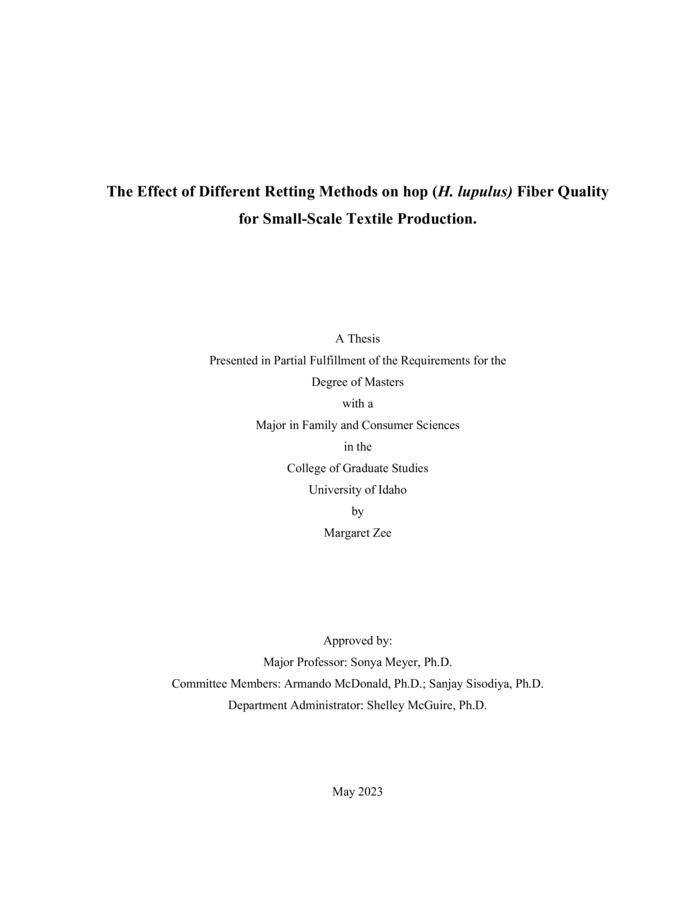The effect of different retting methods on hop (H. lupulus) fiber quality for small-scale textile production.
Zee, Margaret Emily. (2023-05). The effect of different retting methods on hop (H. lupulus) fiber quality for small-scale textile production.. Theses and Dissertations Collection, University of Idaho Library Digital Collections. https://www.lib.uidaho.edu/digital/etd/items/zee_idaho_0089n_12585.html
- Title:
- The effect of different retting methods on hop (H. lupulus) fiber quality for small-scale textile production.
- Author:
- Zee, Margaret Emily
- ORCID:
- 0009-0000-0773-6916
- Date:
- 2023-05
- Keywords:
- Bast fibers Fiber extraction Fibershed Hops Slow fashion Textiles
- Program:
- Family and Consumer Sciences
- Subject Category:
- Textile research; Fashion; Sustainability
- Abstract:
-
Hops bines are a fiber-rich plant annually grown in the Pacific Northwest for the beer industry. Once harvested, the bines become byproducts and are typically mulched or composted. This research is aimed at gathering usable hops fibers to make woven textiles by using traditional biological and mechanical processes adopted from other bast fiber plants. Five different fiber extraction methods were compared; green processing, dry decortication, water retting, breaking to water retting, and dew retting. This research compared key characteristics including fiber length, width, linear density, breaking tenacity, elongation at break, modulus, fiber yield, spinnability, and woven fabric texture between the different methods. Green processing produced fibers that were 116.83mm ± 41.42 in length, a width of 331.9μm ± 188.51, an average linear density of 0.28D ± 0.18, breaking tenacity of 11.16 cN/tex ± 6.52, elongation at break of 3.99% ± 2.29, modulus of 309.1 cN/tex ± 264.83, and a fiber yield of 15.42g ± 7.88. This fiber was the least difficult to spin of the fiber producing methods and required a medium beat to weave. The warm water retting method had an average fiber length of 106.1mm ± 44.08, a width of 369.27μm ± 211.29, a linear density of 0.42D ± 0.39, an average breaking tenacity of 11.69 ± 4.92, elongation at break of 4.41% ± 2.73, a modulus of 387.53 cN/tex ± 215.84, and a fiber yield of 20.59g ± 8.02. These fibers were okay for spinning and woven with a medium beat. The breaking to warm water retting produced 134.21mm ± 55.49 length fibers, had an average width of 634.31μm ± 267.85, linear density of 0.49D ± 0.38, breaking tenacity of 12.49 cN/tex ± 5.81, elongation at break of 3.45% ± 1.07, modulus of 553.41 cN/tex ± 164.88, and fiber yield of 46.34g ± 20.32. The fibers were okay for spinning and were woven with a hard beat. Dew retting produced 79.42mm ± 24.13 length fibers, with average widths of 294.06μm ± 177.67, a linear density of 0.16D ± 0.09, breaking tenacity of 17.89 cN/tex ± 10.41, elongation at break of 3.38% ± 1.24, modulus of 869.55 cN/tex ± 321.11, and fiber yield of 4.58g ± 4.42. Breaking tenacity, elongation at break, and modulus are to be determined. The fibers were difficult to spin and the yarn was woven with a medium beat. Depending on the end use, these fiber methods can be utilized to produce woven and nonwoven materials.
- Description:
- masters, M.S., Family and Consumer Sciences -- University of Idaho - College of Graduate Studies, 2023-05
- Major Professor:
- Meyer, Sonya
- Committee:
- McDonald, Armando; Sisodiya, Sanjay; McGuire, Shelley
- Defense Date:
- 2023-05
- Identifier:
- Zee_idaho_0089N_12585
- Type:
- Text
- Format Original:
- Format:
- application/pdf
- Rights:
- In Copyright - Educational Use Permitted. For more information, please contact University of Idaho Library Special Collections and Archives Department at libspec@uidaho.edu.
- Standardized Rights:
- http://rightsstatements.org/vocab/InC-EDU/1.0/

